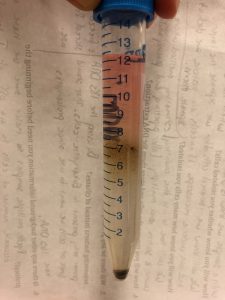Lab 3: Protocol Development and Ciliate Isolation 1/25/18
Objective:
The goal of today’s lab is to develop a protocol that can help us as a class and the scientific community isolate and identify ciliates through metabarcoding. We hope to successfully develop an easily repeatable procedure that it produces significant results. A main part in this is brainstorming multiple procedures to see what would work best which helps us get one step closer to our goal.
Purpose:
The main purpose of lab today and all of our previous labs is to use the Ludox gradient centrifugation technique to isolate cells and extract DNA. We are trying to standardize a metabarcoding method that will include next ten sequencing using 18s DNA primers to identify the eukaryotes present in any given sample. The purposing of using the 18s DNA primers is to ensure that we can easily differentiate between eukaryotes and any prokaryotes present.
Procedure:
1.) Add 8mL of Ludox US 40 to a 15mL conical tube.
2.) Quickly inject 2mL of liquid from the soil samples in the glass mason jars into the tube of Ludox using a p1000 micropipette.
3.) Add 2mL of distilled water (colored with red food coloring) to the top of the Ludox and make sure that you DO NOT mix it into the rest of the solution.
4.) Weigh your conical tube on a scale and compare it to your neighboring group and make sure that the weights of each conical are within 0.1 grams of each other in order to properly prepare the sample to be placed into the centrifuge.
5.) If the tubes are unequal in weight and not within 0.1 grams of one another, place the conical tube open into the jar on the balance (make sure the jar weight had been zeroed out before weighing the conical tube) add more distilled water to the one that was less weight until it is within 0.1 grams of the other one.
6.) Label your conical tube with you group number.
7.) Walk up to the third floor MBC laboratory and view the equipment and learn about the difference between a normal centrifuge and a swinging bucket rotor centrifuge.
8.) Centrifuge in a swinging bucket rotor for 15 minutes at 4300 x g.
9.) While waiting for the centrifuge, brainstorm possible positive and negative controls with your group as well as determine the work flow of today’s experiment.
10.) After the centrifuge cycle is complete, remove the tube from the centrifuge and use a pipette to remove the cell layer which should be in between the Ludox at the bottom of the conical tube and the distilled water sitting on the top layer of the conical tube.
11.) Transfer as much of the cell layer as possible into a clean micro-centrifuge tube.
12.) Label your micro-centrifuge tube with your group number.
13.) Pipette 1-3 drops of the micro-centrifuge sample onto a concavity slide to review under a compound microscope.
14.) Try to locate any possible ciliates using the microscope, if possible take pictures using the MotiConnect app.
13.) Place micro-centrifuge tube in the centrifuge and spin the cells at 1200 x g for 1 minute.
14.) Take out your tube then use a pipette to remove all of the supernatant trying carefully not to disturb the pellet.
15.) Leave the pellet in the tube for the next experiment.
Data/Observations:
This is the conical tube after being taken out of the centrifuge with swinging bucket rotors. The solution separated into three layers, the top was distilled water mixed with red food coloring, the middle was were the majority of the cells were which also contained any debris from the sample, and the bottom layer was the Ludox US 40.
Original Weight: 21.1 grams
weight After Making it within 0.1 grams of the Neighboring Group: 21.3
This is a centrifuge with a swinging bucket rotor which was spun at 4300 x g.
Current Storage:
We placed the micro- centrifuge tube containing the pellet on the back lab counter closest to the computer in an orange rack which will be stored in the freezer until further use.
Future Goal:
The future goal that we would like to establish a concrete metabarcoding protocol that can be used throughout the scientific community to help isolate and classify new ciliates so that we can further our knowledge about soil health and biodiversity.


